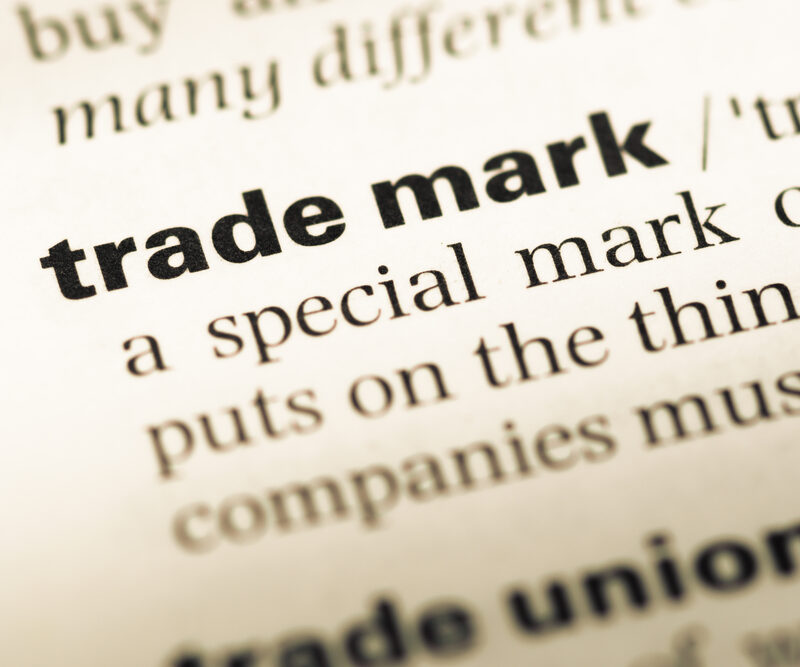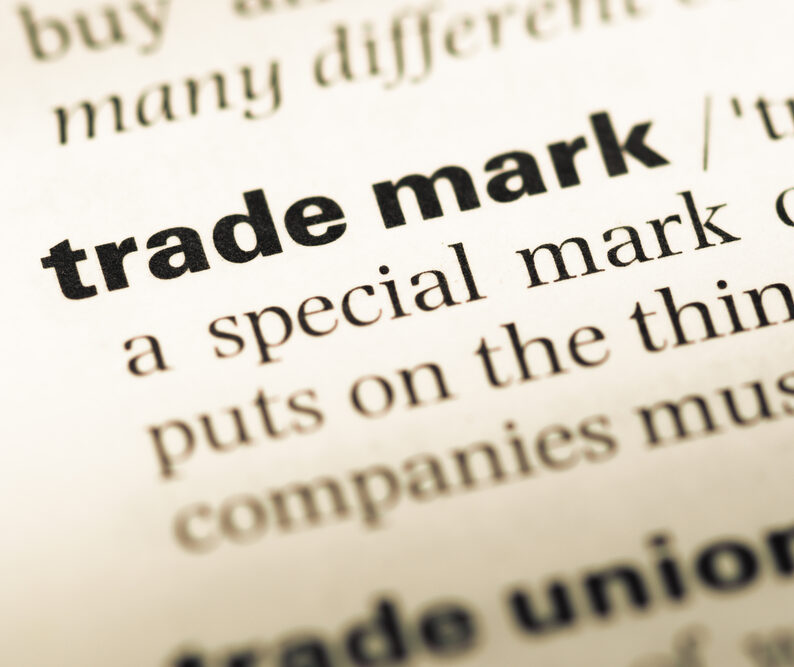

Introduction To Trade Marks
Commonly, trade marks are in the form of a word, a device (logo) or a combination of the two. However, other “signs” such as the shape of a product or its container, sounds or even smells may potentially be registered as trade marks.
Once a trade mark is used, “goodwill” can be generated in the trade mark and the trade mark can become a valuable business asset.
Trade Mark Services
Applying for a Trade Mark
To obtain a registered trade mark, an application must be prepared and filed. Once filed, the Trade Mark Registry will allocate a filing date and number to the application.
Trade Mark Maintenance
Our in-house records department can manage the payment of your trade mark renewal fees. We will provide reminders relating to the deadlines for annuity payments and can make payments of the renewal fees on receipt of your instructions.
Trade Mark Searching
Our trade mark attorneys can conduct preliminary in-house searches of the UK and European databases in respect of trade mark applications and trade mark registrations. We can also request searches to be undertaken by dedicated search organisations or via our overseas associates anywhere in the world. This will determine if your trade mark application is likely to be accepted and ensure that you are not infringing on any registered trade marks
Worldwide Trade Mark
Our trade mark attorneys can advise you of the filing requirements for any country of interest. In addition, if you would like assistance registering a trade mark or taking legal action against trade mark infringement in any country then please contact our expert team of trade mark attorneys today.
Trade Mark FAQs
We’ve compiled a list of our most popular trade mark FAQs. We hope you find these useful. If you have any further questions, please don’t hesitate to get in touch and we’ll do our best to help.A trade mark is a sign which, when used in the course of trade in respect of goods or services, can serve to distinguish one trader’s goods or services from those of other traders. Commonly, trade marks are in the form of a word, a device (logo) or a combination of the two. However, other “signs” such as the shape of a product or its container, sounds or even smells may be registered as trade marks.
Once a trade mark is used, “goodwill” can be generated in the trade mark and the trade mark can become a valuable business asset.
Commonly, trade marks are in the form of a word, a device (logo) or a combination of the two. However, other more unusual “signs” that can function as a trade mark, i.e. signs that are distinctive and can distinguish goods/services of one trader from others, can be registered as trade marks. For example, the shape of a product or its container, sounds or even smells may be registered as trade marks, although this is less common than conventional trade marks.
In order for a trade mark registration to be obtained, the trade mark needs to be distinctive, non-descriptive of the goods or services or their geographical origin, and not excluded from registration due to being generic, deceptive, offensive, laudatory, illegal or immoral.
Registration of a trade mark provides the owner of the registration with the exclusive right to use the trade mark in respect of the goods or services for which the mark is registered. It also provides the owner with the right to take legal action against competitors who might, inadvertently or otherwise, infringe his registered trade mark rights by using the same or a similar trade mark on goods or services identical or similar to the goods or services covered by the registration.
If a trade mark is not registered but is used for a considerable period of time, the trade mark proprietor may have “common law” rights in the mark, which may enable the proprietor to protect their interest in the trade mark against unauthorized use. However, a legal action based on such common law rights, generally known as a “passing off” action, can be more difficult and costly to pursue than an action for infringement of a registered mark.
Therefore, it is generally recommended that trade mark registration is obtained for trade marks.
When thinking of a new trade mark to use, the aim should be to find a mark which is likely to be both protectable (i.e. capable of registration), and which is not in use or registered by other third parties.
To be registerable, the trade mark should ideally NOT be:
- Directly descriptive of the goods or services or their geographical origin;
- Words/terms which have become customary in the particular trade (generic);
- Laudatory, offensive, illegal; and/or
- Deceptive
It is useful to ask a trade mark attorney to perform a trade mark search for your proposed trade mark before you start to use or apply to register the same.
Once a trade mark has been registered, the trade mark protection generally lasts for an initial period of ten years from the date of application. At expiry of the initial ten year period, the registration can be renewed for further periods of ten years, without limit, on payment of a renewal fee.
In order to register a trade mark, an application needs to be filed at the Trade Mark Registry in the country in which you wish to obtain trade mark protection. The application needs to specify the trade mark and the goods or service for which the trade mark will be used. If the trade mark application is in respect of a logo, a representation of the logo will need to be provided.
Once an application for a trade mark registration has been made, the application is examined by the Trade Mark Authorities in order to ascertain whether the trade mark is acceptable for registration. In most cases, an examination report is issued by the Trade Mark Authorities within a few months from the filing date of the application. Any objections raised by the Authorities must be dealt with in order for registration to take place.
Once any objections have been overcome, the trade mark application will be published and any third parties can object to the trade mark. If no objections are raised during publication, or any objections raised are successfully overcome, the application will then proceed to registration.
If you wish to protect your trade mark in one or more foreign countries, this can be done in three different ways:
- File a separate trade mark application in each country in which trade mark protection is required;
- File a European Community trade mark application covering all the countries of the European Union;
- File an International trade mark application under the “Madrid Protocol” designating a number of different countries;
- File an OAPI and/or an ARIPO trade mark application covering multiple African countries as a single application.
If foreign trade mark protection is applied for within a six-month term from filing your first trade mark application, often called the “priority period”, then the foreign trade mark applications will be given the filing date on which your first trade mark application was made.
A trade mark attorney can advise you on the best options for obtaining trade mark protection in the specific countries of interest to you.
It typically takes approximately 5-12 months to obtain a trade mark registration in the UK, depending on whether any objections are raised against the trade mark application.
In order to obtain trade mark registration, official fees need to be paid to the trade mark authorities in whichever country or region trade mark protection is required. The amount of these official fees depends on the numbers of classes of goods or services for which the trade mark registration is applied for and the countries in which trade mark protection is required. A trade mark attorney can provide an indication of costs for obtaining trade mark registration once the above information has been obtained.
Meet Our Trademark Experts

David is a fully qualified UK and European Patent Attorney, as well as a fully qualified UK Trade Mark Attorney and Patent Attorney Litigator. He is a fellow of The Chartered Institute of Patent Attorneys, a Member of The Chartered Institute of Trade Mark Attorneys and is a registered representative at the European Patent Office and the Unified Patents Court.
David entered the profession in 2009, joined Bailey Walsh & Co LLP in early 2012, and became a partner of the firm in January 2020. David holds an MChem (Hons.) degree in Chemistry from Durham University where he gained a very good understanding of all areas of Chemistry. Prior to entering the IP profession, David gained industrial experience in the pharmaceuticals sector working for one of the world’s leading drug development companies. While studying at university, David also gained further academic experience in particle science and engineering working each summer with PhD groups in the engineering department of Leeds University.
David’s patent work covers a broad range of technologies, with a focus predominantly on mechanical and engineering patent matters, drafting patent applications and prosecuting them through to grant, advising and aiding clients with their international filing strategies, and representing clients in opposition and appeal proceedings at the European Patent Office. David’s trade mark qualifications complement his patent work and enable him to provide “full picture” advice to his clients.


David Corbyn

Phil is a fully qualified UK and European Patent Attorney, as well as a fully qualified UK and European Trade Mark Attorney and Patent Attorney Litigator. He is a Fellow of The Chartered Institute of Patent Attorneys, a Member of The Chartered Institute of Trade Mark Attorneys and is a registered representative at the European Patent Office and the Unified Patents Court.
Phil joined Bailey Walsh & Co LLP in December 2006, after a year as a Business Science Fellow at the University of Nottingham gaining experience in how to extract value from the University’s expertise and IP portfolio. Phil holds an MSci and PhD in Chemistry, also from the University of Nottingham.
The multidisciplinary nature of Phil’s doctorate, mixing the disciplines of Chemistry and Chemical Engineering, gave him a solid grounding in many areas of technology including asymmetric chemical synthesis, catalysis, enzymatic reactions, high pressure systems supercritical fluids. As a result Phil handles a broad range of technical subject matter in patent drafting and prosecution including artificial intelligence and medical devices.
Alongside Phil’s patent work he manages clients’ trade mark and design portfolios and has represented many national and international clients before the UK Trade Marks Registry and at the European Office, in both prosecution work, opposition and invalidation actions.


Philip Stephenson

Michelle is a fully qualified UK and European Trade Mark Attorney, as well as a fully qualified Trade Mark Formalities Officer. She is also a Member of The Chartered Institute of Trade Mark Attorneys.
Michelle has worked for Bailey Walsh & Co LLP for over 34 years and has gained extensive experience in the filing and prosecution of trade marks, and the management and prosecution of trade marks in UK, Europe, China, USA the Middle East and Far East. Michelle has in depth knowledge of trade mark filing strategies around the world. She is also responsible for the management of the trade mark portfolios for some of our largest clients. Michelle has expertise in the filing of defensive trade mark registrations in China to provide greater protection and strength in dealing with Customs Officials and the exporting of goods from China.


Michelle Kellett

Paul is a fully qualified UK and European Trade Mark Attorney. He is a Chartered Secretary and a Member of the Institute of Trade Mark Attorneys.
Paul joined Bailey Walsh & Co LLP in 1984 after working in industry for several years, and became a partner of the Firm in 1997. Paul holds an Honours degree in Law from The University of Sheffield.
Paul works extensively on trade mark and registered design matters within the firm and has significant experience in the prosecution and enforcement of trade mark rights both in the UK and overseas. He has an impressive repertoire of clients which he has acquired as a result of his excellent reputation, ranging from large multinational companies to assisting in the protection of start-up companies. Paul undertakes extensive licensing work for trade marks, and is well aware of the ability to use trade marks to extend protection for the commercial aspects of a business beyond the expiry of other intellectual property rights and therefore extend the revenue which can be generated.


Paul Dyson

